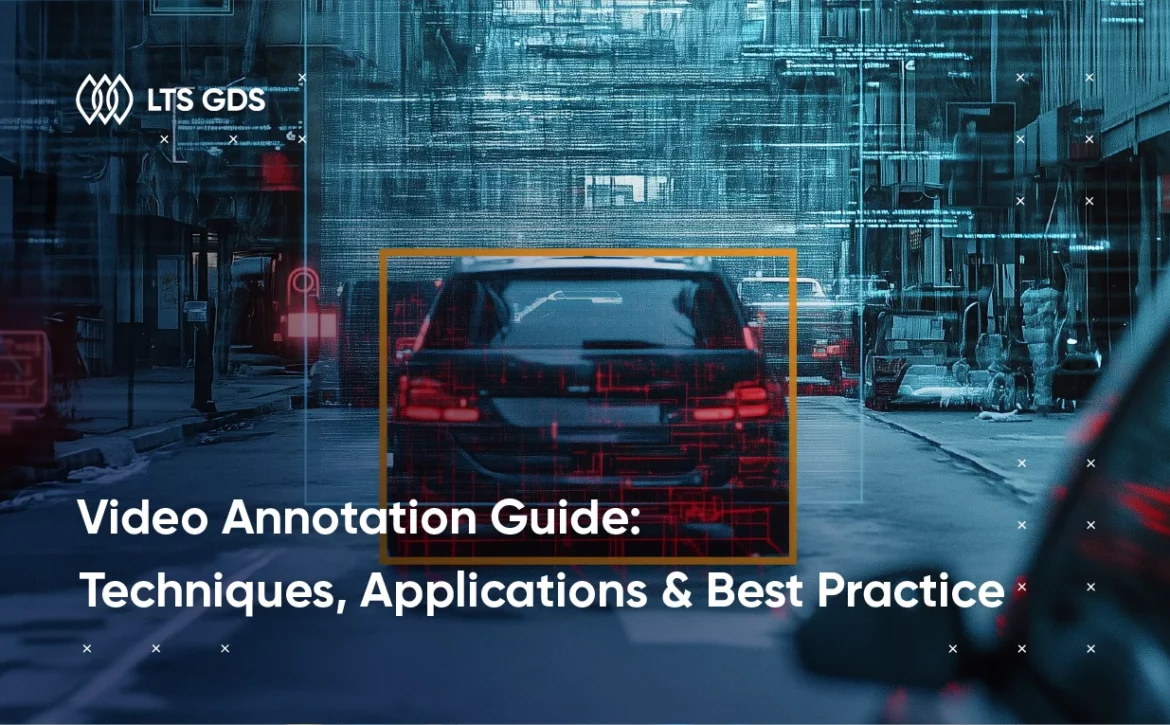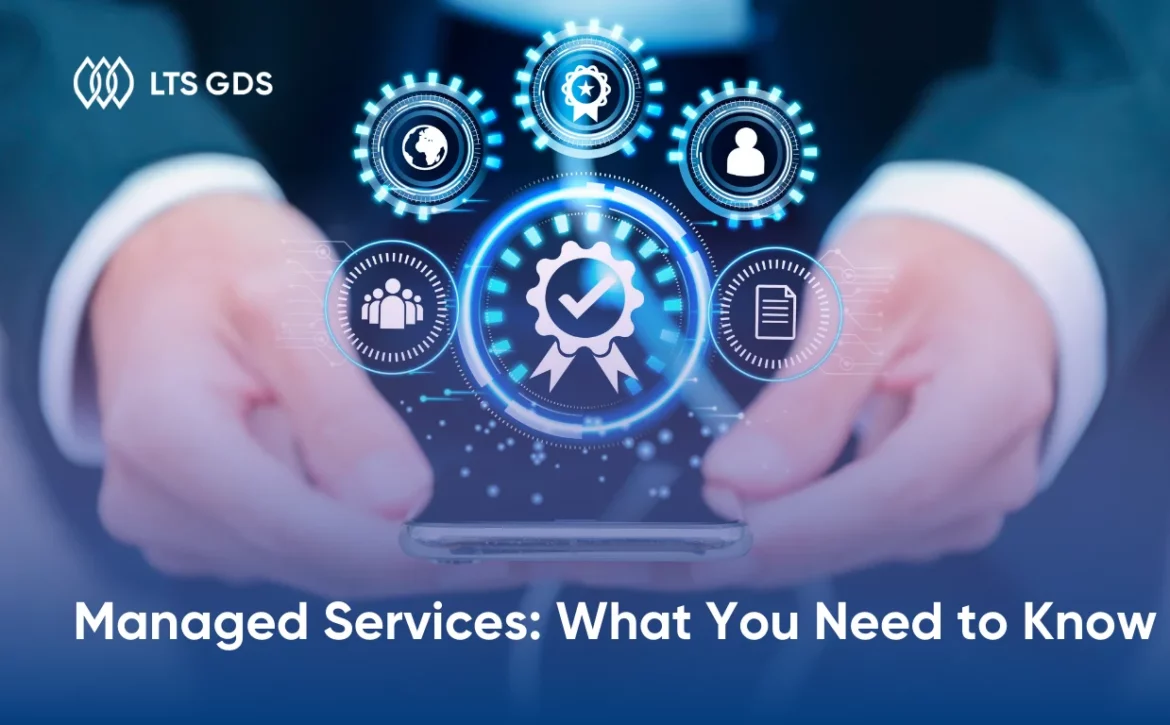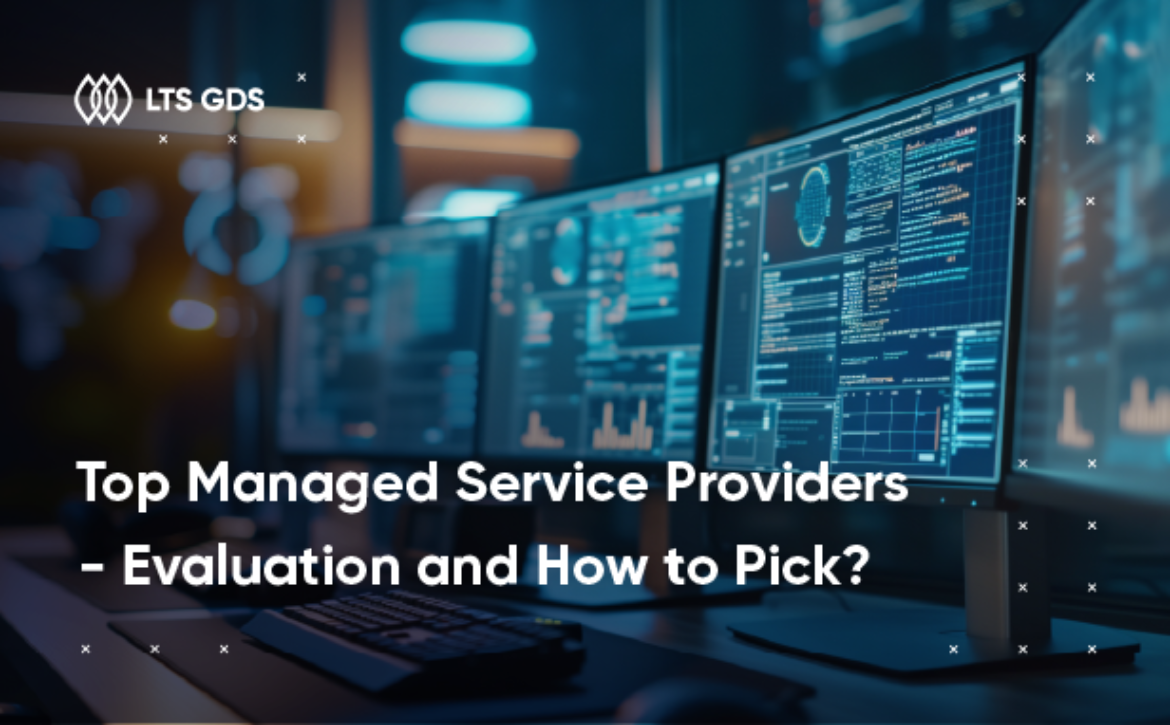Data Annotation Pricing: The Complete Cost Guide for Enterprise AI Projects in 2025
In 2025, the demand for precise, scalable AI solutions hinges on one critical factor: high-quality data annotation.
According to recent market forecasts, the global data annotation market is set to jump up from $1.7 billion in 2024 to over $2.26 billion in 2025, reflecting a staggering CAGR of 32.5%.
This surge is fueled by the growing adoption of AI across sectors such as autonomous vehicles, healthcare, and finance, where precision in labeled data directly feeds into model accuracy and business outcomes.
However, as companies dive into large-scale annotation projects, many quickly run into the challenge of balancing cost, quality, and turnaround time. Annotation complexity, data volume, and accuracy demands heavily influence pricing, with rates varying from simple text labeling to advanced image and 3D point cloud segmentation.
Choosing the right data labelling pricing model, whether per-label, hourly, or project-based can significantly impact budgets and project timelines.
This blog will break down the complex landscape of data annotation pricing in 2025, explore cost optimization strategies, and demonstrate how partnering with a global digital services leader like LTS GDS can unlock superior value for your enterprise’s AI initiatives.
Understanding Outsourcing Data Annotation Pricing Models
When outsourcing data annotation, selecting the right pricing model is essential to control costs while ensuring quality and timely delivery. The three most prevalent pricing structures in the industry today are the hourly rate pricing model, per-label pricing structure, and project-based fixed pricing. Each model has distinct advantages and fits different project requirements and business goals.
Hourly rate pricing model
The hourly rate model charges clients based on the actual time annotators spend working on the project. This approach is particularly suited for complex, variable tasks where annotation time per unit can fluctuate significantly, such as detailed semantic segmentation or 3D image annotation .
Hourly rates typically vary by annotator expertise and geographic location, with rates ranging from $4 to $12 per hour depending on skill level and region.
This model offers flexibility when project scope or annotation complexity is uncertain or evolving, making it particularly suitable for long-term projects where requirements may change over time. It also allows clients to scale up or down resources quickly without renegotiating contracts, providing adaptability throughout the project lifecycle. However, it requires close monitoring of time spent and may lead to unpredictable costs if workflows are inefficient.
Per-label pricing structure
Per-label pricing charges based on the number of individual annotations or labels applied to the dataset, such as bounding boxes, polygons, or text tags. This model is ideal for projects of any scale, from small to large, as long as annotation tasks and volumes are well-defined.
Pricing per label varies by annotation type and complexity. For example, bounding boxes may cost around $0.02 – $0.04 per object, while polygon or semantic segmentation can be $0.06 or higher per label due to increased effort.
The pay-per-label model provides cost transparency and predictability, enabling clients to forecast expenses by multiplying the expected label count by the unit price. It also incentivizes efficiency, as providers aim to optimize annotation speed and accuracy to maximize throughput. This structure fits well with automated or semi-automated workflows where labels can be counted and tracked precisely.
Project-based fixed pricing
Project-based fixed pricing sets a lump-sum cost for the entire annotation project based on a clearly defined scope and deliverables. This model suits enterprises with stable, well-scoped datasets and annotation requirements, offering budget certainty and simplified contract management. It often includes multiple quality assurance (QA) cycles, revisions, and project management overhead.
For example, a subscription or retainer model might require prepayment for a set volume of annotations over a period, often with discounts of 20 – 50% compared to one-time projects.
However, this approach is rarely used and generally only suitable for small, short-term projects with clearly estimable scope and budget. It is not ideal for continuous annotation workflows, since data is rarely sent in regular, consistent batches that would allow carrying over the same price or predictable ramp-up.
Due to the high risks and variability, most clients and providers avoid this model. Occasionally, for very small projects with budgets slightly exceeding the estimate, a flat-fee arrangement may be accepted when it benefits both sides.
The downside is less flexibility if project scope changes or data complexity increases. Rigid as it may seem, it provides peace of mind for enterprises prioritizing fixed budgets and clear timelines.
Summary
| Pricing model | Best suited for | Pricing basis | Advantages | Considerations |
| Hourly rate pricing | Complex, variable annotation tasks | Cost per annotator hour | Flexible resource scaling; adaptable to changing scope | Requires close time monitoring; cost can vary |
| Per-label pricing | Large-scale, repetitive annotation tasks | Cost per individual label | Transparent, predictable costs; incentivizes efficiency | May not suit highly variable or complex tasks |
| Project-based fixed pricing | Well-defined, stable projects | Lump sum for entire project | Budget certainty; simplified contract management | Less flexible if scope changes; potential renegotiation needed |
- Hourly rate suits complex, variable tasks with fluctuating workloads.
- Per-label pricing fits large, repetitive datasets with predictable annotation units.
- Project-based fixed pricing offers budget certainty for well-defined, stable projects.
Choosing the right model depends on your project’s complexity, volume, timeline, and quality requirements. LTS GDS leverages flexible data annotation pricing strategies to align with client needs, helping enterprises cut through cost complexities and scale up AI initiatives efficiently.
For a deeper dive into how these pricing models impact your business AI project budget and quality, explore related insights on data annotation pricing and outsourcing strategies.
Key Factors Influencing Data Annotation Cost
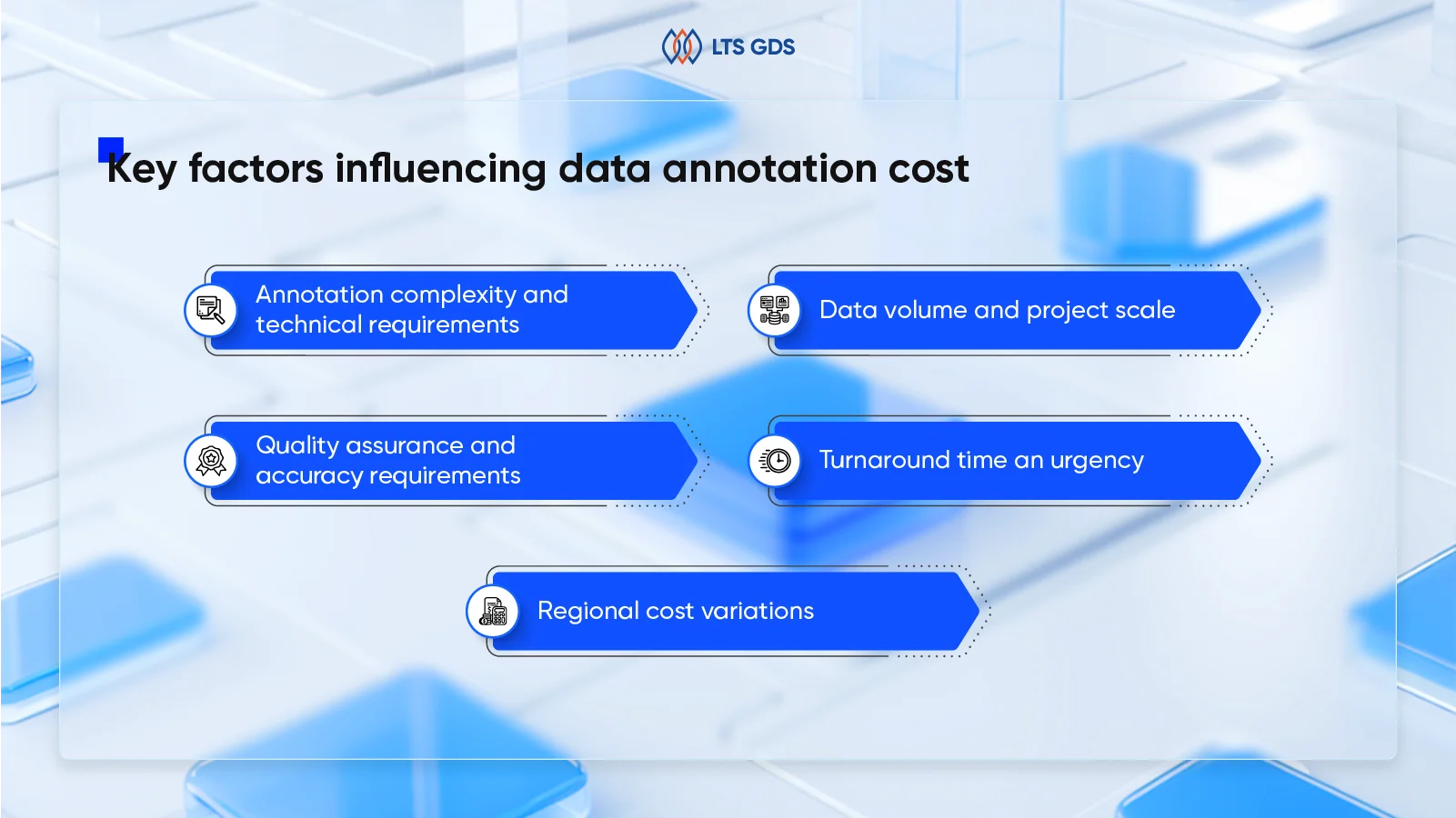
Annotation complexity and technical requirements
The complexity of annotation tasks is the foremost driver of cost. Simple labeling tasks such as basic text tagging or bounding boxes on images generally incur lower costs, often starting around $0.03 – $0.05 per label.
However, as annotation demands grow more intricate (such as semantic segmentation, instance segmentation, 3D point cloud annotation, or multi-class video frame labeling), the required expertise, time, and tooling increase substantially, pushing prices higher.
For example, medical imaging annotation can cost 3 to 5 times more than general image annotation due to the need for domain experts with specialized knowledge. Similarly, autonomous driving datasets require annotators skilled in identifying rare edge cases, which also commands premium pricing. Advanced annotation often involves multi-layered quality assurance and manual verification, further adding to costs.
Data volume and project scale
Project size significantly affects per-unit pricing. Large-scale projects typically benefit from economies of scale, with some providers offering tiered pricing structures or volume discounts. For instance, volume-based annotation pricing discounts often apply above 500,000 annotations.
However, scaling up also introduces overhead as managing large annotation teams, coordinating workflows, and maintaining quality control become more complex and costly. Thus, project managers must balance volume benefits against increased coordination and QA expenses.

Quality assurance and accuracy requirements
High-quality annotations are non-negotiable for reliable AI model performance but come at a premium. Rigorous quality assurance processes such as multi-tier reviews, consensus labeling, and rework cycles, require additional time and skilled personnel.
The cost impact is significant: projects demanding accuracy levels above 95% involve expert annotators and extensive validation, increasing hourly rates and per-label prices. Cutting corners on QA can lead to poor model outcomes, costly retraining, and project delays, ultimately inflating total costs.
Turnaround time and urgency
Delivery timelines directly influence pricing. Rush jobs typically command premium rates due to resource prioritization. This price differential stems from:
- Rapidly recruiting and training additional staff
- Expanding annotation tool capacity
- Maintaining 24/7 workflows across global teams
Some larger annotation providers maintain globally distributed teams across different time zones to offer expedited service with more stable pricing. Nevertheless, accelerated timelines almost invariably mean higher costs.
Regional cost variations
Labor costs vary widely by region, influencing annotation pricing. Outsourcing annotation to countries with lower wages can reduce expenses, with hourly rates as low as $5 – 7 in some regions.
However, regional cost advantages may come with trade-offs in communication, time zone alignment, and quality control. Leading providers mitigate these risks through robust project management and training. Hence, it is advisable that enterprises weigh cost savings against potential impacts on accuracy and delivery speed.
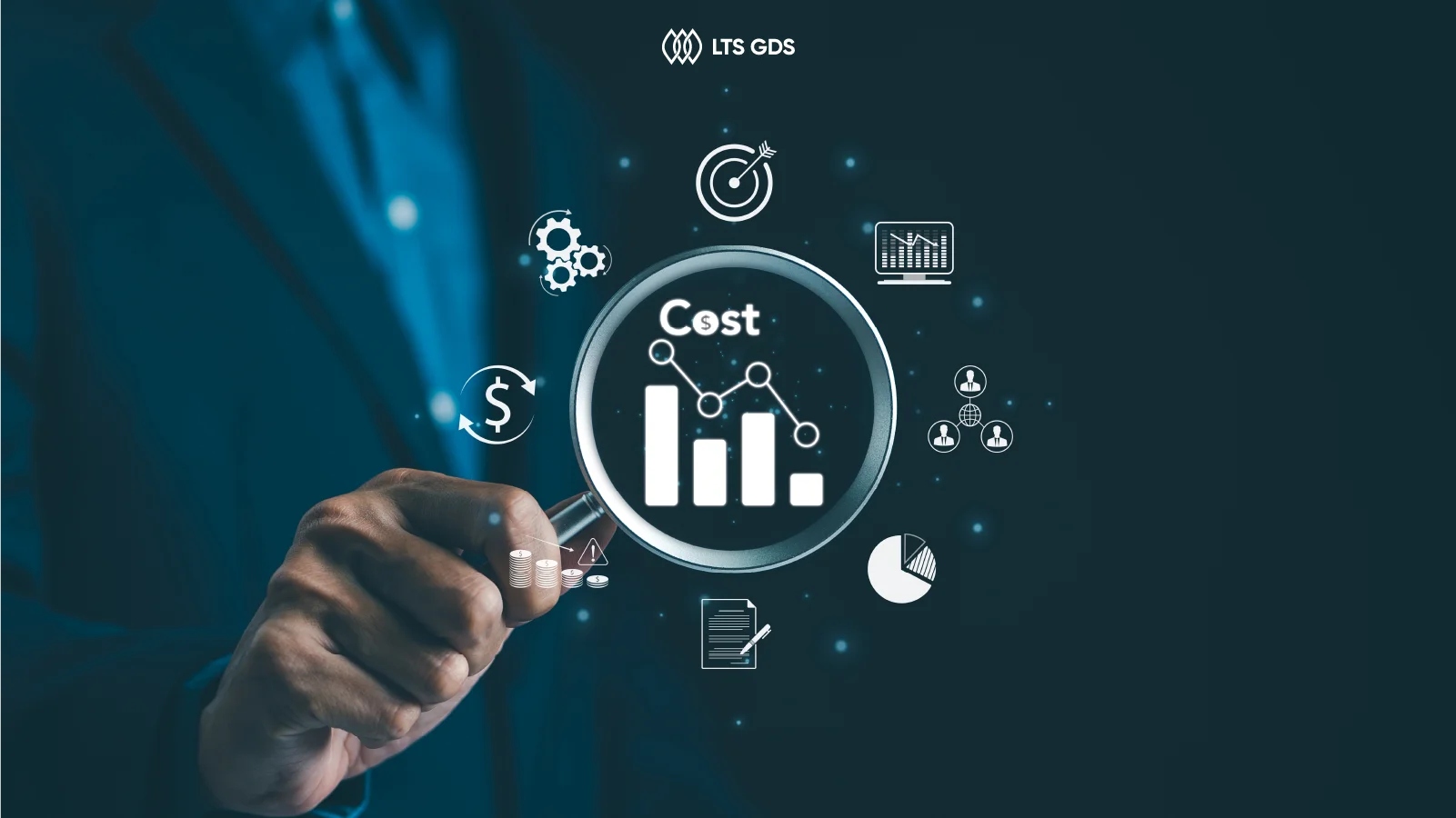
For further insights on annotation complexity and types, see our detailed guides on image segmentation and semantic vs. instance segmentation.
Cost Breakdown by Annotation Type
Data annotation pricing varies significantly depending on the type of data and the complexity of the annotation task. Below is a detailed breakdown of common annotation types and their typical cost ranges, reflecting industry benchmarks and market trends in 2025.
Note:
- The data annotation pricing figures presented below are intended as general industry benchmarks and reference points based on current market research and provider disclosures.
- Actual costs can vary significantly depending on project specifics such as annotation complexity, data quality, volume, turnaround time, and vendor capabilities.
- Enterprises are advised to engage directly with annotation service providers like LTS GDS to obtain tailored quotes that reflect their unique requirements and ensure optimal cost-efficiency and quality outcomes.
| Annotation type | Description | Typical time per project | Estimated price | Providers & pricing details | Notes |
| Bounding boxes | Draws rectangular boxes around objects | 5 – 10 seconds | $0.03 – $0.08 per object | – Label Your Data: ~$0.04
– Basic AI: ~ $0.03 – Amazon: ~$0.08 |
Most affordable; ideal for high-volume, budget-sensitive projects |
| Polygons | Traces exact object outlines using connected points | 30 seconds – 3 minutes | Starts at ~$0.04 per object; varies with detail | – Mindkosh: ~$0.07 for ≤8 points; higher for complex shapes | Offers higher precision than boxes; used when accurate boundaries are needed |
| Semantic segmentation | Labels every pixel based on object class | Very time-consuming | ~$0.84 – $3.00 per image | – Average: ~$0.84
– Mindkosh: ~$3.00 |
One of the most labor-intensive and expensive annotation types |
| Instance segmentation | Similar to semantic segmentation but distinguishes individual instances | More time-consuming than semantic seg. | Same or higher than semantic segmentation | For large-scale projects requiring instance segmentation, the total costs can be substantial. For example, estimated: ~$225,400 for 2.3M objects (with volume discount) | Suitable for cases where each object must be uniquely identified |
| Keypoint annotation | Marks specific points on objects (e.g., for pose or facial features) | Relatively fast | $0.01 – 0.03 per keypoint | – Label Your Data: ~$0.01
– Basic AI: ~ $0.02 – Others: ~$0.03 |
Cost-effective; valuable for tasks such as motion tracking or pose estimation |
| Video annotation | Frame by frame labeling for object/ action tracking and temporal segmentation | Very time-consuming; scales with frame count | $0.10 – $0.50+ per frame | Varies with resolution & complexity | Used in autonomous driving, surveillance, sports analytics, and activity recognition |
| Audio annotation | Labels speech, sound events, speakers, sentiment in audio data | Varies by language/domain/task | $0.10 – $0.30 per audio minute | Higher for medical or multilingual data | Critical for voice assistants, speech-to-text, emotion/sentiment recognition |
| Text and NLP annotation | Tags entities, sentiment, intent, categories in text | Simple to complex (task-dependent) | $0.01 – $0.15 per text unit | AI + human review helps reduce costs | Supports NLP tasks like chatbots, sentiment analysis, document classification |
| Time series annotation | Labels sequential, temporal data (sensors, financial, IoT) | Varies widely; expert-driven | Project-based or hourly | Depends on domain expertise | Applied in predictive analytics, anomaly detection, signal interpretation |
| Multimodal annotation | Integrates multiple data types (e.g., image + text or audio + video) | Complex workflows and high coordination | 50% – 100% premium over single modality | Custom pricing based on modality and scope | Enables cross-modal AI (e.g., video captioning, emotion from voice + facial expression). |
| Code annotation | Tags logs, code, or outputs for ML in software, security, or debugging | Highly specialized | Custom and project-specific | Niche; priced by expertise | Powers AI in code generation, cybersecurity, and debugging support |
How Pricing Models Vary Among Top Data Annotation Companies
The data annotation market features diverse pricing approaches among leading providers, each tailored to different enterprise needs and project requirements. Understanding these variations helps businesses select the most cost-effective data annotation partner or the best-suited image annotation company for their specific use cases.
1. Service providers
| Company | Pricing model | Core offerings & differentiations |
| LTS GDS | Project-based, hourly, per-label | – End-to-end managed annotation services with deep domain expertise in ADAS, healthcare, BFSI, and more;
– Rigorous four-layer quality assurance process ensuring up to 98% accuracy (Check out LTS GDS’s QA process here); – Seamless integration with software development and robotic process automation (RPA) workflows; – Competitive cost advantage leveraging Vietnam-based operations. |
| iMerit | Premium customized per-label | – High-precision manual annotation catering to complex verticals like healthcare and autonomous vehicles;
– Strong compliance focus including GDPR, HIPAA, and data security standards; – Dedicated quality assurance teams with continuous verification processes. |
| CloudFactory | Hourly + per-label | – Scalable managed workforce optimized for large, rapidly growing projects;
– Human-in-the-loop workflows enabling iterative model training and refinement; – Flexible operational model that adapts well to evolving and iterative project requirements. |
| Scale AI | Premium per-label, project-based | – Enterprise-grade annotation services designed for highly complex, high-volume AI projects;
– Advanced quality assurance with strong security and regulatory compliance; – Specialized expertise in autonomous vehicles, natural language processing, and other AI-focused industries. |
Key notes
- These companies deliver annotation as a managed service, handling workforce, QA, and project management.
- Pricing is typically customized, reflecting project complexity, data type, and required accuracy.
2. Annotation tools & platform
| Company | Pricing model | Core offerings & differentiations |
| LabelBox | Subscription, per-label | – Self-serve platform empowering users to control annotation workflows independently;
– Built-in AI-assisted annotation tools to accelerate labeling; – Real-time collaboration features enabling multiple users to work simultaneously. |
| CVAT.ai | Hourly + per-label | – Combination of managed workforce with human-in-the-loop for quality control;
– Strong focus on scalability for large annotation projects; – Highly flexible for iterative annotation cycles and evolving project needs. |
| Kili Technology | Subscription + usage based | – SaaS-centric solution integrating advanced workflow automation, quality analytics, and dataset insights;
– Extensive API integrations enabling seamless connection with other ML and data tools. |
Key notes
- These platforms provide the software and workflow tools for in-house teams or contractors to perform annotation.
- Pricing is often based on usage (number of labels, data volume, or seats), with self-service and enterprise options.
In-house vs Outsourcing Data Annotation Pricing Analysis
Choosing between in-house and outsourced data annotation significantly impacts your enterprise’s AI project’s budget, quality, scalability, and operational complexity. Both approaches have distinct cost structures, advantages, and challenges.
| Factor | In-house annotation | Outsourced annotation |
| Upfront costs | High (hiring, training, infrastructure) | Low (pay-per-task or subscription) |
| Scalability | Limited (fixed staff) | Flexible (scale resources as needed) |
| Quality control | Full control over process and standards | Vendor-managed; requires active oversight |
| Setup time | Long (recruitment, training) | Short (immediate access to skilled annotators) |
| Data security | High control over sensitive data | Potential risks; mitigated by contracts and SLAs |
| Operational overhead | High (management, infrastructure, training) | Moderate (vendor coordination and communication) |
| Cost structure | Fixed and indirect costs | Variable costs based on volume and complexity |
| Flexibility | Lower; scaling up/down is slow | High; rapid adjustment to project needs |
| Expertise access | Limited to internal hires and training | Access to specialized domain experts globally |
| Best use case | Stable, ongoing, sensitive annotation needs | Variable volume, tight deadlines, cost optimization |
Final verdict
- In-house annotation offers greater control and security but requires significant investment and operational overhead. It suits organizations with stable, sensitive, or highly customized annotation needs.
- Outsourcing provides cost-effective scalability and access to expertise with lower upfront costs but demands vigilant vendor management to maintain quality and security. It is ideal for projects with variable volume and tight timelines.
- Hybrid approach: Many enterprises adopt a hybrid model, combining in-house teams for sensitive or core annotation tasks with outsourcing for volume spikes or less sensitive data. This approach balances control, cost, and flexibility.
Please refer to our full article on in-house vs outsourcing data annotation: Pros, cons & costs for the full analysis and actionable insights on:
- When to choose in-house annotation for maximum control and data security
- How outsourcing accelerates time-to-market and optimizes operational costs
- The common pricing models and hidden costs associated with both approaches
- Key risks and mitigation strategies for vendor management and quality assurance
- Practical guidance on evaluating and selecting the right annotation partner
Hidden Costs and Budget Planning
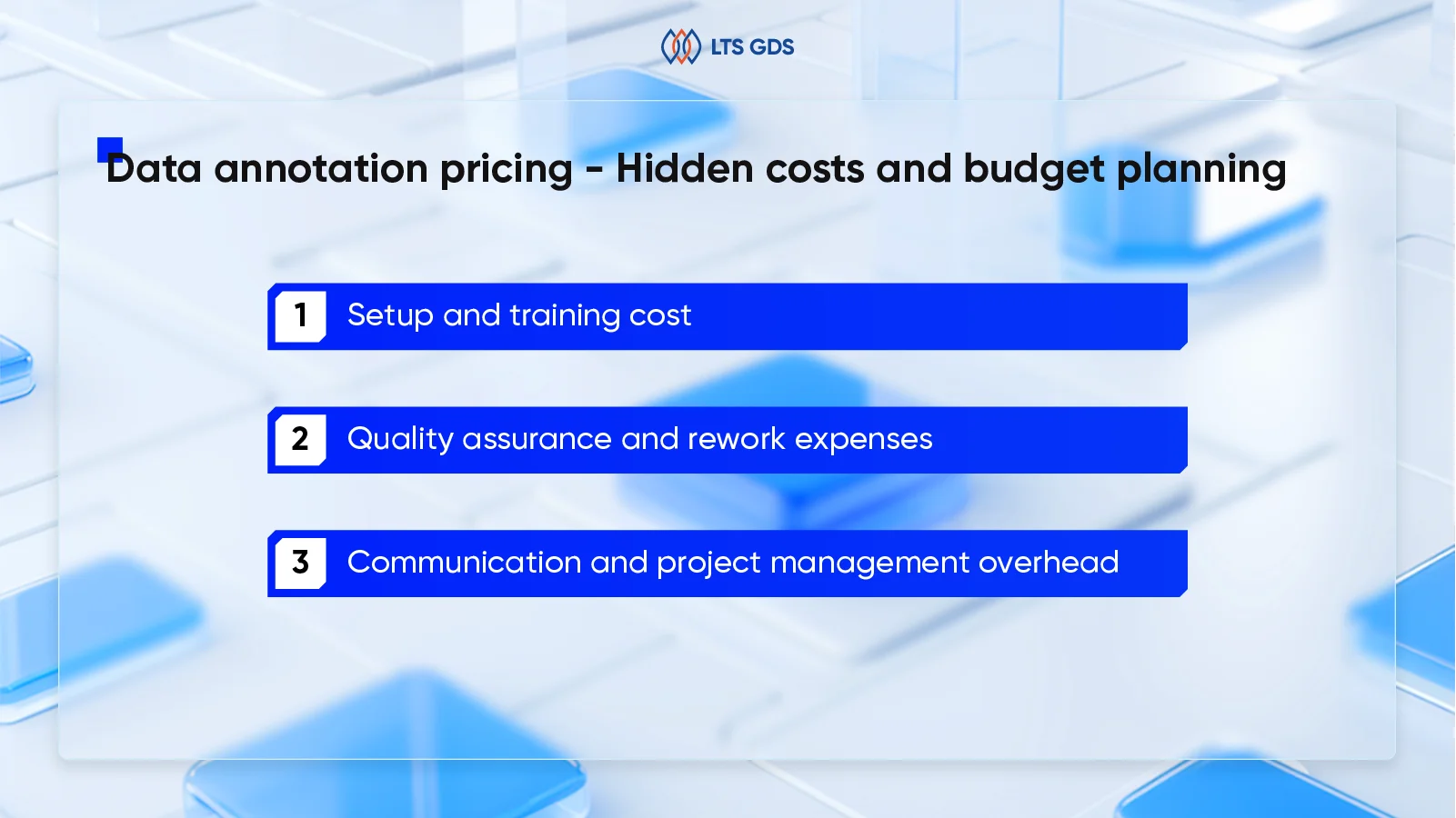
1. Setup an in-house annotation team
Hidden cost
Establishing an in-house annotation requires significant investment in recruiting, onboarding, and training annotators. This includes time spent on educating workers about complex guidelines and ensuring consistency. High turnover rates can further increase these costs due to repeated retraining cycles.
Optimization
- Leverage AI-assisted pre-labeling: Use AI tools to generate initial annotations, reducing manual effort and training time. Human annotators then focus on refining complex cases, speeding up onboarding and improving productivity.
- Outsource to experienced providers: Partner with annotation vendors who already have trained, domain-expert teams, eliminating your internal training burden and infrastructure costs.
- Standardize clear guidelines: Develop comprehensive annotation manuals and examples upfront to minimize confusion and reduce training iterations.
2. Quality assurance and rework expenses
Hidden cost
Poor annotation quality leads to costly rework, including multiple review cycles and corrections. Inaccurate labels delay model training and increase operational expenses.
Optimization
- Implement multi-layer quality control: Use multi-step review processes combining human checks and AI-assisted validation to catch errors early.
- Balance quality and cost: Avoid over-investing in perfection; apply AI-assisted pre-annotation and focus human effort on critical or complex data points.
- Pilot small batches: Test annotation workflows on small samples first to identify issues before scaling, reducing large-scale rework.
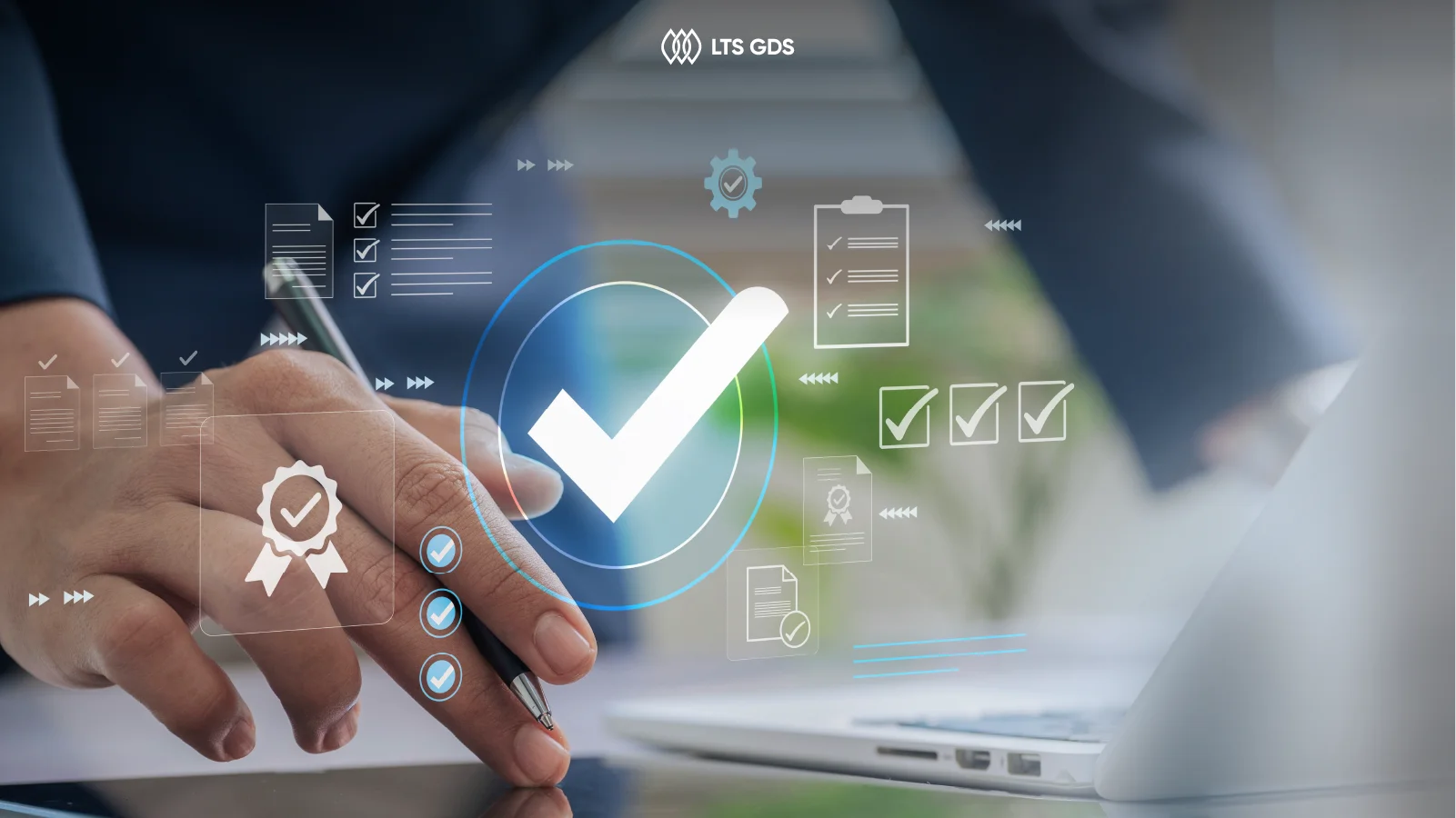
3. Communication and project management overhead
Hidden cost
Managing annotation projects requires ongoing coordination between data scientists, annotators, and vendors. Miscommunication, time zone differences, and unclear instructions can cause delays and increase costs.
Optimization
- Use collaborative annotation platforms: Tools (such as Labelbox or Kili Technology) enable real-time feedback and centralized communication, reducing misunderstandings.
- Define clear annotation guidelines: Well-documented, unambiguous instructions minimize back-and-forth clarifications.
- Establish dedicated project managers: Assign experienced coordinators to streamline communication and promptly resolve issues.
FAQ about Data Annotation Pricing
1. What factors influence the cost of data annotation services?
The main factors include:
- Annotation type and complexity (e.g., bounding boxes vs. semantic segmentation)
- Data volume,
- Quality requirements,
- Domain expertise needed,
- Turnaround time
For example, more complex tasks and specialized domains like medical imaging or autonomous driving generally command higher prices.
2. How are data annotation services typically priced?
Common pricing models include:
- Pay-per-label/unit: Charging per annotated object or text entity.
- Hourly rates: Paying annotators by the hour, often $5-$7 per annotator hour.
- Fixed-price projects: One-time fees for well-defined datasets.
- Subscription models: Regular payments for ongoing annotation needs.
*Note: Pricing varies by provider and project specifics
3. How can I optimize costs when outsourcing data annotation?
Cost optimization strategies include:
- Volume negotiation and long-term partnerships: Committing to larger annotation volumes or longer contracts often unlocks discounted rates and better service terms.
- Quality-cost balance optimization: Combining AI-assisted pre-annotation with targeted human review reduces manual effort while maintaining accuracy, avoiding expensive rework.
- Clear guidelines and efficient communication: Reducing costly delays and rework by minimizing misunderstandings.
4. Can I estimate annotation costs before starting a project?
Many providers offer cost calculators or free pilot projects to help estimate pricing based on your data type, volume, and annotation complexity. This helps set realistic budgets and expectations.
How Does LTS GDS Turbocharge Your Enterprise’s Next AI Projects?
Understanding data annotation pricing models is one thing, translating that understanding into a tangible competitive advantage is another. At the end of the day, the question isn’t just “What will it cost?” but rather, “How does our investment in data annotation accelerate our path to AI success?” This is where LTS GDS transcends the role of a vendor to become your team’s strategic partner in value creation.

From cost center to value catalyst: Achieving strategic budget elasticity
We believe your enterprise’s budget should be a catalyst for innovation, not a constraint. Our pricing model, engineered for optimal efficiency through our strategic operations in Vietnam, offers more than just competitive rates – it provides budget elasticity.
Our efficient operational model provides enterprises the elasticity to expand the scope and depth of their data initiatives without a corresponding budget increase. This flexibility means R&D teams are no longer forced to choose between data volume and data complexity. Instead, they can pursue both, annotating larger, more diverse datasets and tackling more intricate tasks to build the sophisticated, resilient, and market-differentiating AI models that drive true innovation.
Accelerating time-to-market with guaranteed accuracy
The hidden cost in any AI project is rework. Inaccurate data creates a vicious cycle of re-labeling, re-training, and re-deploying, burning both time and resources. LTS GDS turbocharges your timeline by eliminating this bottleneck.
Our guaranteed 98-99% accuracy rate is not merely a metric but an operational accelerant. It liberates data science and engineering teams from data janitorial roles, allowing them to focus on high-value tasks like algorithm optimization and innovative feature development. This uncompromising commitment to quality creates a direct, predictable, and accelerated path from project inception to successful market deployment.
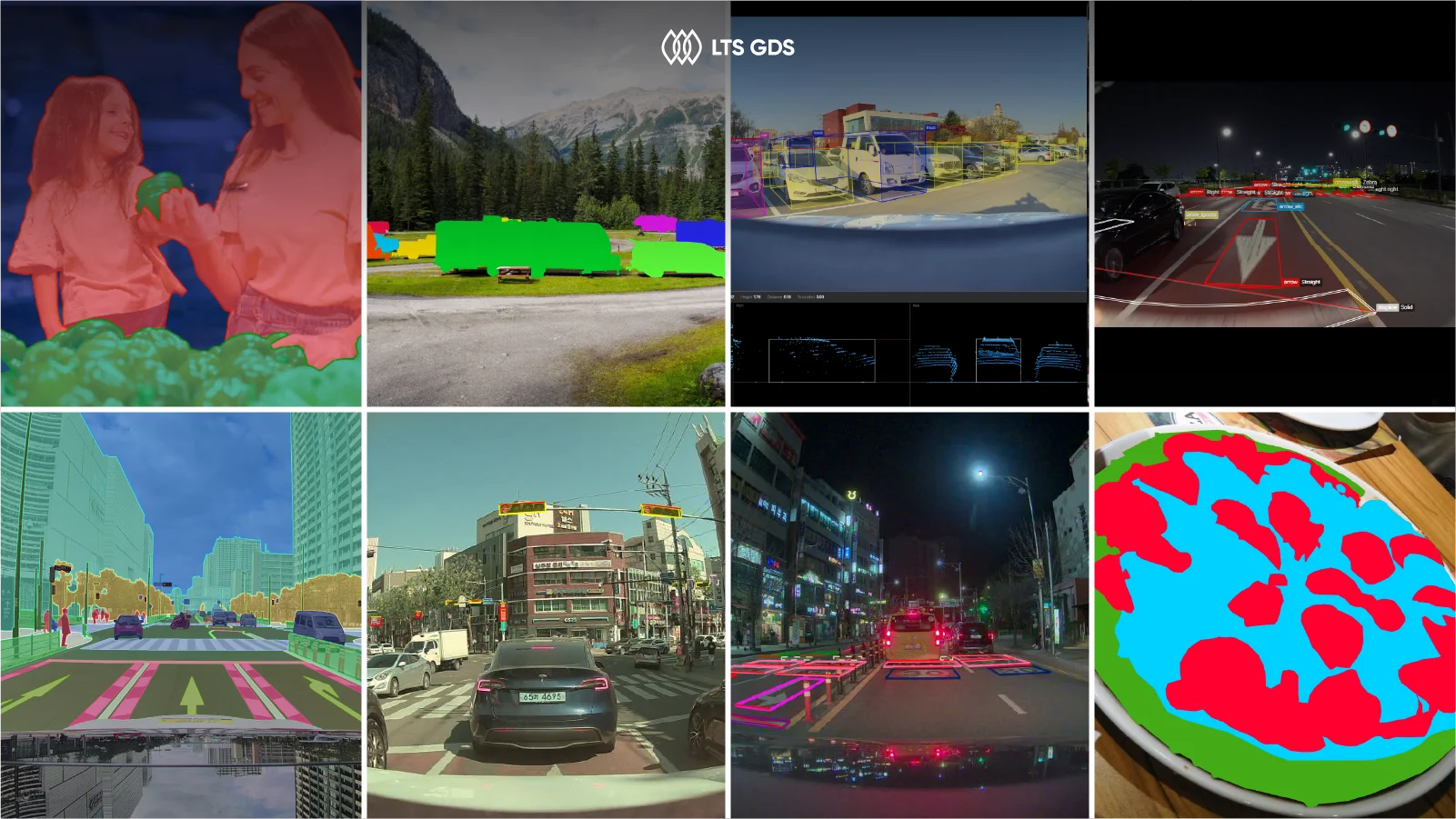
De-risking the AI roadmap through security and scalability
Ambitious AI initiatives face two primary operational risks: security vulnerabilities and resource bottlenecks. LTS GDS addresses both, effectively de-risking the enterprise roadmap.
Our ironclad adherence to standards like ISO 27001 and GDPR acts as a comprehensive shield, protecting invaluable enterprise intellectual property and ensuring stringent regulatory compliance. Simultaneously, our proven capacity for rapid team scaling provides a critical buffer against project stagnation.
Whether a project needs to accelerate to meet a market opportunity or pivot to new requirements, our operational agility ensures momentum is maintained. This dual approach to risk mitigation provides enterprises with the stable, secure, and predictable foundation necessary to pursue long-term AI strategies with confidence.
Beyond The Price Tag – Investing in Your Business’s AI Future
Navigating the landscape of data annotation pricing reveals a crucial business truth: the initial price tag is merely one data point in a much larger well thought out equation. A purely cost-focused approach often overlooks the significant “quality tax” – the hidden expenses of rework, delayed timelines, and underperforming AI models that inevitably result from subpar annotation.
Ultimately, the most insightful pricing model is the one that delivers the greatest strategic return.
Developing an effective data annotation strategy is crucial for the success of any AI project. By choosing the right pricing and engagement model aligned with project goals and complexities, organizations can optimize costs, improve data quality, and accelerate AI development. A well-planned annotation approach not only ensures accurate training data but also strengthens a company’s position in the rapidly evolving AI landscape.






